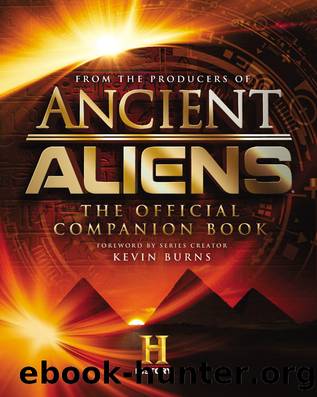Ancient Aliens® by The Producers of Ancient Aliens

Author:The Producers of Ancient Aliens [Producers of Ancient Aliens, The]
Language: eng
Format: azw3
Publisher: HarperCollins
Published: 2016-10-11T00:00:00+00:00
A skull reputed to be that of Mary Magdalene, dipped in gold and encased in a golden headpiece, at the Basilique Sainte-Marie-Madeleine in Saint-Maximin-la-Sainte-Baume, France. Medieval legend held that, after fleeing the Holy Land, Mary Magdalene sailed across the Mediterranean to France, eventually retiring to a cave in the Sainte-Baume mountains. At her death it was said she was buried in Saint Maximin.
Lynn Johnson / National Geographic Magazines / Getty Images
The bones of the saints who were known to be prophets were the most coveted. Being in the presence of relics of a saint who was known to be a prophet, like John the Baptist, for example, could bring you powers of prophecy. John the Baptist was an itinerant preacher who became famous for baptizing people in the Jordan River. He is found in all of the canonical gospels. Legends of his ministry exist in the Koran and in the historical writings of Josephus. But in Christianity, John the Baptist is specifically important because he is known as “the forerunner” or “the precursor”—the person who is supposed to come before the Messiah. The Old Testament says that prior to the Messiah, a prophet will come and announce the arrival of the Messiah. Those are the shoes that John the Baptist fills.
It was believed that the bones of John the Baptist were brought to Europe during the Crusades. In 2010, a sarcophagus was discovered in the ruins of a church in Bulgaria, in a place known as the Island of John. This is a location that has held an annual celebration for John the Baptist for at least fifteen hundred years. Within the ornate marble sarcophagus were six bones. An inscription on the sarcophagus refers to John the Baptist and his birthday or his feast day. Geneticists tested the bones and determined that they are indeed from the first century and come from a man of Middle Eastern origin. So it is possible that these bones are those of John the Baptist.
Download
This site does not store any files on its server. We only index and link to content provided by other sites. Please contact the content providers to delete copyright contents if any and email us, we'll remove relevant links or contents immediately.
| Direction & Production | Genres |
| Guides & Reviews | History & Criticism |
| Reference | Screenwriting |
| Shows |
Head of Drama by Sydney Newman(2020)
Robin by Dave Itzkoff(2003)
I'm Judging You by Luvvie Ajayi(1887)
The Paranormal 13 (13 free books featuring witches, vampires, werewolves, mermaids, psychics, Loki, time travel and more!) by unknow(1847)
Single State of Mind by Andi Dorfman(1509)
Ten by Gretchen McNeil(1489)
#MurderTrending by Gretchen McNeil(1389)
Key to the Sacred Pattern: The Untold Story of Rennes-le-Chateau by Henry Lincoln(1348)
Most Talkative by Andy Cohen(1309)
Merv by Merv Griffin(1262)
This Is Just My Face by Gabourey Sidibe(1176)
Notes from the Upside Down by Guy Adams(1176)
Jamie Oliver by Stafford Hildred(1144)
The Hunger Games: Official Illustrated Movie Companion by Egan Kate(1116)
Springfield Confidential by Mike Reiss(1102)
Clarkson--Look Who's Back by Gwen Russell(1077)
The TV Writer's Workbook: A Creative Approach To Television Scripts by Ellen Sandler(1069)
Blue Planet II by James Honeyborne & Mark Brownlow(1018)
Dark Angel by D. A. Stern(1010)
